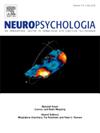年轻人和老年人大脑皮层对相干与非相干运动刺激的早期处理:调查视觉诱导牵引的事件相关电位(ERP)研究
IF 2
3区 心理学
Q3 BEHAVIORAL SCIENCES
引用次数: 0
摘要
向量的神经生理基础(即自我运动的幻觉)还没有得到很好的理解。初步证据表明,神经预测因子可以通过事件相关电位(ERPs)来识别,这些标记物可能与向量强度相关。目前的研究考察了在感知诱发刺激的早期阶段,神经皮层活动的年龄相关差异。22名年轻人(年龄范围:20-35岁)和25名老年人(年龄范围:65-83岁)在两个区域观察到光动力学刺激,一个短(~ 3s)呈现区和一个长(35s)呈现区。在两种类型的脑块中,光动力刺激在运动相干性(相干运动和非相干运动)方面有所不同。在短呈现时段,EEG以erp的形式测量视觉运动开始时的神经活动,而在长呈现时段,则收集向量强度、持续时间和开始潜伏期的主观评分。在两个年龄组中,连续运动和非连续运动后的对流明显更强。ERP分析显示,在100-150 ms (P1)和150-230 ms (P2)时,顶枕电极的相干运动和非相干运动存在差异,非相干运动和相干运动的曲线下面积(AUC)更大。在连续视觉运动方面,矢量评分和erp均无显著的年龄差异;然而,在非连贯视觉运动的加工过程中,观察到erp的年龄差异。这些结果表明,随着年龄的增长,视觉转换的主观体验和视觉加工的神经生理机制保持相对稳定。然而,它们也揭示了在处理非相干运动方面与年龄相关的差异。本文章由计算机程序翻译,如有差异,请以英文原文为准。
Early cortical processing of coherent vs. non-coherent motion stimuli in younger and older adults: An event-related potential (ERP) study investigating visually induced vection
The neurophysiological basis of vection (i.e., the illusion of self-motion) is not well understood. Preliminary evidence suggests that neural predictors of vection can be identified through event-related potentials (ERPs) and that these markers may correlate with vection intensity. The current study examined age-related differences in neurocortical activity during the early stages of sensory processing of vection-inducing stimuli. Twenty-two younger (age range: 20–35 years) and 25 older adults (age range: 65–83) observed optokinetic stimuli in two blocks, a short (∼3s) presentation block and a long (35s) presentation block. In both types of blocks, the optokinetic stimuli varied in motion coherence (coherent vs. non-coherent motion). During the short presentation block, EEG was used to measure neural activity in the form of ERPs time-locked to the onset of visual motion, whereas subjective ratings of vection intensity, duration, and onset latency were collected during the long presentation block. Vection was significantly stronger following coherent vs. non-coherent motion for both age groups. ERP analyses revealed differences between coherent and non-coherent motion at parietal-occipital electrodes around 100–150 ms (P1) and 150–230 ms (P2), with greater area under the curve (AUC) during non-coherent vs. coherent motion. Neither vection ratings nor ERPs showed significant age differences for coherent visual motion; however, age differences in ERPs were observed during the processing of non-coherent visual motion. These findings indicate that the subjective experience of vection and the neurophysiological mechanisms underlying visual processing preceding vection remain relatively stable with age. However, they also reveal age-related differences in the processing of non-coherent motion.
求助全文
通过发布文献求助,成功后即可免费获取论文全文。
去求助
来源期刊

Neuropsychologia
医学-行为科学
CiteScore
5.10
自引率
3.80%
发文量
228
审稿时长
4 months
期刊介绍:
Neuropsychologia is an international interdisciplinary journal devoted to experimental and theoretical contributions that advance understanding of human cognition and behavior from a neuroscience perspective. The journal will consider for publication studies that link brain function with cognitive processes, including attention and awareness, action and motor control, executive functions and cognitive control, memory, language, and emotion and social cognition.
 求助内容:
求助内容: 应助结果提醒方式:
应助结果提醒方式:


